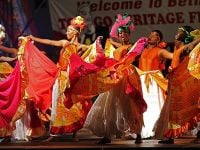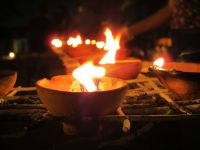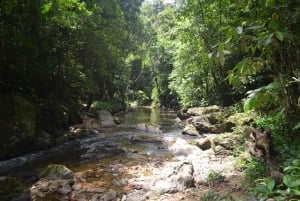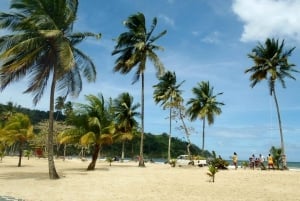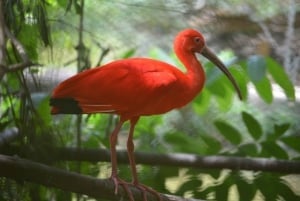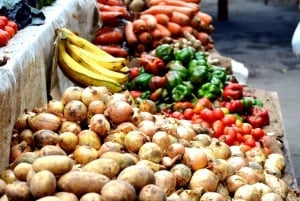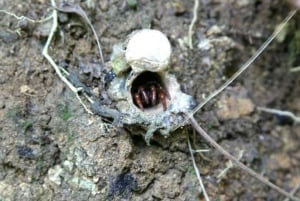Festivals and Public Holidays
Trinidad and Tobago's cosmopolitan nature becomes very clear when it comes to celebrating diversity as a nation. Many immigrants brought their religous,cultural and national practices with them to the islands, while some holidays developed out of national achievements.
As a country Trinidad and Tobago has possibly the most public holidays of any other in the world. Or atleast thats what Trinis would love you to think.
Carnival
Trinidad and Tobago's carnival is not relegated to the two days before the Christian Lenten fast but encompasses a series cultural, musical and historical events between Christmas and Ash Wednesday.
Carnival took root in Trinidad during the 18th-century when French planters brought their tradition of pre-Lenten masquerade balls to Trinidad. They would dress up in elaborate costumes depicting aspects of French folklore. Their African slaves were not allowed to partake in these festivities and in turn held their own version of the masquerade in secret called canboulay. Many slaves also used this opportunity to incite revolts against their otherwise pre occupied masters.
After the abolition of slavery by the British in 1838, the colonial government relentlessly fought against the now-Africanized carnival making it illegal to beat drums, wear masks and even dance in the streets. By the 1930s these attempts to suppress the drum lead the invention of steel drum or steel pan. Crafted from discarded oil drums, pan as it is affectionately called is the only musical instrument to be invented in the last century.
Despite attempts to ban its celebration, canboulay now commonly known as ‘Mas’ exploded onto the streets of Port of Spain. Traditional depictions of devils, midnight robbers, bats and moko jumbies can be seen up to present day. Mas has evolved into a massive street party with thousands of beautifully costumed revelers dancing through the streets to the infectious sounds of soca music. Soca, is the musical child of Calypso and East Indian rhythms and is the music of Carnival.
Carnival in Trinidad is 100% inclusive. Whether you chose to spectate on the sidelines or pay to join in a Carnival Band (groups of masqueraders depicting a theme) visitors are welcome to take a chip (follow a band) or wine (gyrate your hips) as the nation celebrates what has been dubbed The Greatest Show on Earth.
Where and when:
Travel to Trinidad for Carnival is usually scheduled a week before the Monday and Tuesday preceding Ash Wednesday. A big part of Carnival are the Fetes (outdoor music festivals), Panorama (Steel-band competition), Calypso Tents (showcase of traditional calypsonians). Most of these events are in and around Port of Spain and occur before the two days of mas. Typically visitors book accommodation to the western side of the island in and around the capital. You can expect to pay up to twice the usual cost for accommodation as this is the high season for travel to the twin island republic. Also try to book at least a year in advance, Flights and accommodation go quickly. Most visitors stay until the weekend after Carnival to wind down and with enjoy visiting the beaches around Trinidad and Tobago.
Easter
Ash Wednesday see all the revelry of Carnival Monday and Tuesday subside and the annual Christian Lenten fast begins. The forty days of Lent is a time of fasting and prayer in commemoration of the death and resurrection of Jesus Christ.
Easter is celebrated on Good Friday and Easter Monday as public holidays. The Easter “long weekend” finds Trinidadians outdoors camping, boating Down ‘D’ Islands (DDI) or enjoying one of the many beaches.
On Good Friday, many locals partake in the tradition of eating fish, served with boiled sweet potatoes, yams, green bananas and assorted ground provisions. Hot Cross Buns are also a traditional Easter treat. These soft, sweet buns have a symbolic icing cross on the top.
Towns and villages across the islands also place effigies of Judas Iscariot, known locally as the “Good Friday Bobolee.” It’s usually hung in a central location and beaten for Judas betrayal. There are also interesting myths surrounding going into the sea on Good Friday. It is said that you would mystically turn into a fish.
Eid-ul-Fitr
Islamic in origin, Eid-ul-Fitr is observed by Muslims worldwide. Eid-ul-Fitr is celebrated after the rise of the new crescent moon and marks last few days of the month of fasting called Ramadan.
During Ramadan Muslim families give sadagah al-fitr (charity of fast-breaking) to those in need, usually with gifts of sawine, a creamy, dessert made with milk and vermicelli (noodles) or rice, dates. Early the morning of Eid, Muslims visit mosques for a sermon and a brief congregational prayer called the Eid prayer.
After the Eid prayer is the Khutbah where Imams remind the Muslim community about their commitments to Allah and responsibilities towards fellow Muslims and human beings as a whole. At the end of the proceedings Muslims engage in a special Salaat invite their non-Muslim neighbors, friends and coworkers to experience Muslim culture first hand through Eid festivities.
Divali
Written in Sanskrit Dipavali or “dipa” lamp and “avali” a row. (Row of lamps) pays homage to the Hindu Goddess of light, prosperity and wealth, Lakshmi. It celebrates the victory of light over darkness in the world.
Divali is celebrated as the "festival of lights" during the months of October and November. Hindu devotees conduct prayers, shares sweets and snacks and at dusk, everyone joins in lighting of fire crackers and the rows Deyas lamps around the home and yard.
The ideals and traditions of Divali are celebrated by most Trinidadians with the eating of curry dishes, the lighting of deyas becoming cultural traditions.
Spiritual Baptist/Shouter Baptist Liberation Day
Trinidad and Tobago is the first and only country in the world to recognize and celebrate the Spiritual Baptist faith. On March 30th every year, a public holiday is given to commemorate the repeal of the Shouter Prohibition Ordinance that prohibited the activities of the faith.
Phagwa
Phagwa, also known as Holi, is a Hindu festival that was first introduced in 1845 by indentured East Indian labourers. Phagwa usually takes place during the months of March and April and is a rite of purification to promote good health. The festival includes tons of dancing, singing and powdered, coloured dyes which is sprayed on participants while they dance to the infectious beats. Despite being a Hindu ritual, people of other religions are free to partake in the festivities.
Arrival Day
Once again, Trinidad and Tobago is the first country to recognize the indentureship of East-Indians, who first arrived from the Indian subcontinent in 1845. They were brought to the islands after the abolition of slavery as a replacement labour force on the sugar plantations. Many Indian cultural practices and religious customs were maintained with these new immigrants as they were allowed by the colonial government to practice their customs. Hinduism and Islam are still practiced by many of the descendants of these immigrants which has added to Trinidad and Tobago’s cultural brew. It wasn’t until the 1990s, that Indian Arrival day was celebrated as a public holiday.
Corpus Christi
Corpus Christis, The Feast of the Body of Christ, is a public holiday that is mainly observed by persons of the Roman Catholic faith. The Catholic Spaniards first carded the holiday, which is usually celebrated on the Thursday following Trinity Sunday, as a holiday before the British colonized the islands. On this day processions take place throughout the country, however the biggest and most impressive procession is in front of the Cathedral located on Independence Square in Trinidad’s capital.
Hosay
Though it is not a public holiday, Hosay is celebrated and observed by Shi’a Muslims around the world. The largest Hosay observance is held in St. James and usually runs for four days in April, May or June according to the Islamic lunar Calendar. During Hosay multi-coloured flags are paraded through the streets, small and large Tadjahs are carried throughout the streets while Tassa drums are played and devotees can be seen dancing with each other. Prayers are offered for the dead, and in order to ensure that prayers are answered, the Tadjahs are dismantled and disposed of as an offering.
Emancipation Day
150 years after the abolishment of slavery in the British West Indies, Trinidad and Tobago declared August 1st Emancipation Day a national holiday and today, T&T is known as the Emancipation Capital of the world. Leading up to Emancipation, the Trans-Atlantic Exposition which attracts Traders from Africa, the Caribbean and North America is set up at the Queen's Park Savannah. Patrons can buy African garb, artifacts, handmade jewellery, purchase African delicacies and enjoy traditional African music and performances. The Kamboule is a street procession that features drums, steelband, dance troupes and moko jumbies. Apart from this procession, religious services take place and the day usually concludes with a Torchlight Procession that leads to the National Stadium which reenacts the rebellion against slavery.
Labour Day
June 19th marks the anniversary of te Butler Oilfield Riots in 1937. On that day, workers striked and rioted on the sugar plantations and oil fields due to worker abuse of many forms. The holiday is meant to honour those who stood for what was right and just as well as the achievements of workers throughout T&T. Marches, ceremonies, rallies and cultural shows sums up the holiday.
Independence Day
On August 31st 1962, Trinidad and Tobago gained its Independence from Great Britain and naturally, the day is celebrated annually on that very date. The day starts with a parade of the military beginning in the capitals of both islands before taking to the streets. Various militant forces are accompanied by live music from their respective bands while spectators line the streets. The celebrations then conclude with fireworks displays in both capitals
Republic Day
Trinidad and Tobago became a republic on August 1, 1976, however it is not celebrated until September 24th. The new date commemorates the first parliament meeting under the new Republican constitution. In 2002, the holiday was reinstated after being absent for three years prior.
Christmas
Of all our holidays, Christmas is the most anticipated and most social for locals. Its a time for family and copious amounts of food and drink. The radio stations play Trinidadian Christmas carols and songs as well as traditional and contemporary carols from the USA. Leading up to Christmas there are tons of parties that appeal to both adult and child: children parties, charity events, dinners and Parang competitions and showcases. Parang was brought to Trinidad by Venezuelan migrants who were primarily of Amerindian and African heritage, something which is strongly reflected in the music itself. The word is derived from two Spanish words: parranda, meaning "a spree or fête", and parar meaning "to stop".
In the past, it was traditional for parang serenaders to pay nocturnal visits to the homes of family and friends, where part of the fun was waking the inhabitants of the household from their beds. Today, a new form of parang, soca parang, has emerged. Soca parang is a combination of soca and parang. Parang season usually begins in September, with radio stations playing parang tunes and Christmas music, and performances by parang bands in mall and other public locations.
Most people paint and make repairs to their houses and hang new curtains and decorations (especially lights) for Christmas. Often, this is the time that most people buy new electrical appliances and furniture. Most families spend Christmas Day at home with friends and family members.
The Christmas day meal is usually prepared throughout mid-December, and into the new year! The traditional Trinibagonian Christmas meal include apples and grapes, sorrel, ponche-de-creme (a version of egg nog), ham, turkey, homemade bread, ginger beer, pastelles (a version of tamales) and local wine. Trinidadian Christmas fruitcake is traditional and is eaten in most homes.
New Year's Eve is known as 'Ole year's night' in Trinidad, and people love to let off fireworks to celebrate the coming of the new year!
Tobago Heritage Festival
The Tobago Heritage Festival is a major annual event on the national calendar and spans a two-week period from mid July to early August. The Festival expresses the soul of Tobago, and is fast becoming the main event on the Tobago calendar. We dare to say its becoming for Tobago what Carnival is for Trinidad.
Its a time where Tobago's dance, song, music and cuisine takes center stage and are celebrated. Each event takes visitors from one heritage venue to another, through quaint and picturesque villages of Tobago. A perfect opportunity to explore the island.
Enjoy events such as the Traditional Tobago Wedding, the Buccoo Goat and Crab Races. Every day or night one is treated to the indigenous cultural art forms that are the heart of Tobago. Patrons may savour the traditional culinary delights and thrill to the pulsating rhythms and dances and the varied oral traditions.
Make sure to visit our EVENTS section to keep updated with all that is happening throughout the year!


